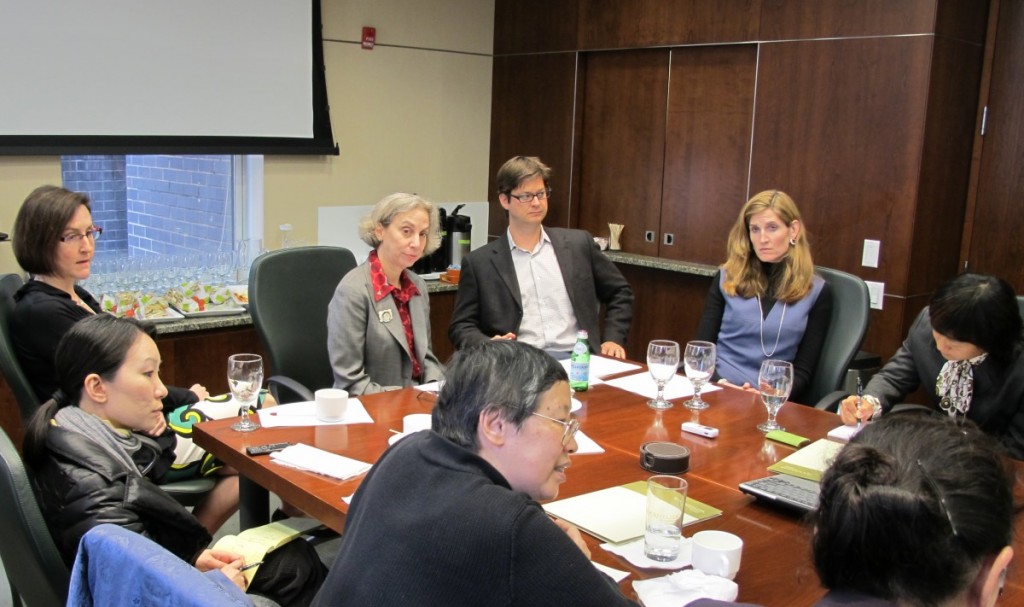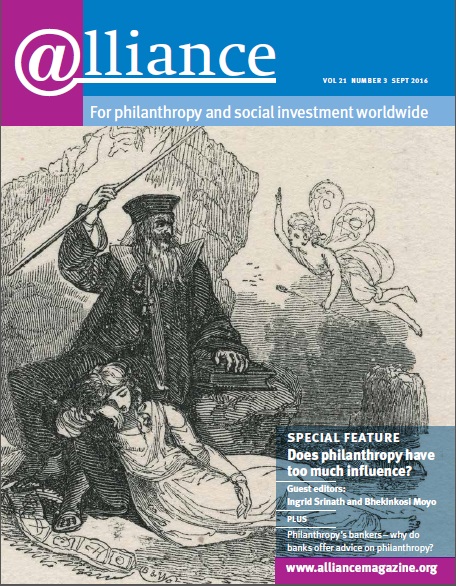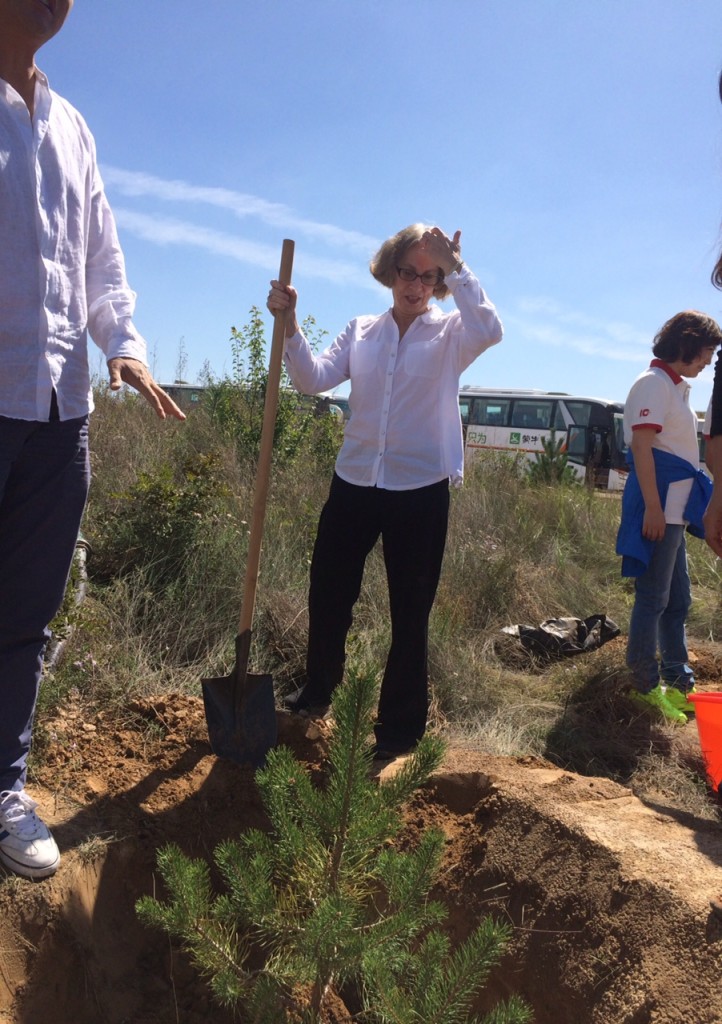As president and CEO of Rockefeller Philanthropy Advisors (RPA) and an adjunct professor at Columbia University’s Business School, Melissa Berman is closely involved in philanthropy’s growing – and increasingly global – ecosystem. She talks to Charles Keidan about developments in the philanthropy advisory world, how philanthropy is ‘retooling’ to play a greater role in policy and development, and RPA’s work on the Theory of the Foundation.
How has the philanthropy advisory world changed since you joined Rockefeller Philanthropy Advisors (RPA) in 2002?
When we first started, it was a very new field, and it wasn’t even clear that it was going to take off. But as more and more philanthropists have decided that they want to tackle problems at their root, or that they want to tackle larger problems than they can deal with individually, the sense that there’s a body of expertise and resources to help has become more broadly accepted. That’s not just the case in the US, but in other parts of the world too.
How does the service you provide differ if your client is an established organization or, say, a family that’s just starting out on its philanthropic journey?
In the latter case, they can discuss everything, from motivations to how they want to work and assess progress, so it’s really a blank slate. With more established donors, it’s often a question of assessing how the work is going and whether they are happy with it in the light of new developments. But sometimes even established foundations reach a turning point where they are in some ways looking at a blank piece of paper.
‘I think a global culture of giving and social investing is developing. Business people and wealth holders are much more globalized.’
You mention that the field is developing internationally. How do you see it changing outside the US?
I think a global culture of giving and social investing is developing. Business people and wealth holders are much more globalized. They are much more likely to have been educated at least partly outside their home country; they have global business interests, and global networks of friends and colleagues. So we’ve seen the emergence of interest in philanthropy in East and South Asia and Latin America and elsewhere. Some of our guides are now available in Mandarin, Korean, Spanish and Portuguese, and we’re in talks about having them translated into other languages.
Is RPA setting up offices outside the US?
We have one in London and we may open another one in Europe in order to be part of the current flowering of European philanthropy, and possibly in Asia and Latin America later on. We always like to work with local partners and that has been especially important in our work in China. But even within the US we sometimes work with a local partner to make sure that we understand the nuances of a particular region.

Lead photo: Running a seminar for Chinese philanthropists in RPA’s NYC office (along with three RPA board members).
Why did you choose London as your first overseas office?
Our interest in building out our work in Europe, especially through the Theory of the Foundation project, coincided with the launch of the Marshall Institute for Philanthropy and Social Entrepreneurship at the London School of Economics (LSE). We wanted an academic partner for some of this work: while the practitioner perspective is important, so is the academic way of looking at an issue.
You mentioned China a moment ago – who are you working with there?
We have a partner there called the China Global Philanthropy Institute, with whom we’ve been exchanging programmes for the last four or five years, presenting seminars, organizing philanthropy education tours in the New York area for Chinese wealth holders, and getting our materials and presentations translated.
What do the philanthropy education tours involve?
Many of the people on these tours are entrepreneurs running family-owned businesses, so they are interested in how US families that launched a business and then became philanthropic set about it – the Rockefeller family, the Ford Foundation, and so on. They’re also interested in the very new foundations set up by people like Michael Bloomberg, and Jim and Marilyn Simons, so we bring people like that to talk with them. We also provide some context because we want to give them a sense of how all of these pieces fit into a kind of ecosystem of philanthropy.
One area that you’ve been very focused on is the Sustainable Development Goals. How did that arise?
We were approached by some of the early developers of this project – the Conrad N. Hilton Foundation, the Ford Foundation and the MasterCard Foundation – to become the third leg of an implementation stool that also includes UNDP and the Foundation Center. UNDP is where all the expertise is on the SDGs and the connections to UN member nations. The Foundation Center is building a data platform to code both philanthropic and public sector funding against each SDG. Our role is to bring in private philanthropy, corporate donors and other actors who can see their work as part of the SDGs.
‘Each institution or individual has its own assumptions and you have to be able to find common ground, so that people are talking to each other rather than past one another, which has often been a challenge in multi-stakeholder conversations.’
Each institution or individual has its own assumptions and you have to be able to find common ground, so that people are talking to each other rather than past one another, which has often been a challenge in multi-stakeholder conversations. This approach wasn’t part of the MDGs and, although great progress was made, I think it would have been greater if there had been more of a shared understanding of the MDGs and how individual players contribute to them.
‘The SDGs are not just global; they are also more comprehensive than the MDGs. They deal with environmental issues, equity issues and rights issues, which allows different players to see themselves and their work in them.’
The SDGs are explicitly intended to apply to the global North as well as the global South. Is there a risk that that could divert resources from extreme poverty in the global South to addressing serious inequality in the global North?
I think that’s a false dichotomy. Economic systems are interconnected, so tackling inequality anywhere will help achieve the goals.
The SDGs are not just global; they are also more comprehensive than the MDGs. They deal with environmental issues, equity issues and rights issues, which allows different players to see themselves and their work in them. We’ve found great receptiveness to these ideas in Indonesia, Kenya, Italy and Brazil, to name a few countries where platforms are emerging.
Do you think universities are becoming more engaged with the needs of philanthropy practitioners?
I think more and more business schools, policy schools, even schools that deal with social services, recognize that understanding philanthropy is increasingly important to understanding how change happens. Many business students really want some involvement, whether after or during school, in social change organizations or social enterprises. Businesses also recognize that the people they’re trying to recruit want that involvement, both personally and in the company they work for. We’ve seen philanthropy institutes emerging in Chile, Brazil and China and in several parts of Europe.
The course in global philanthropy that I teach at Columbia Business School brings together people from all over the world. Many of the students are planning to go into banking, consulting, real estate and other lines of business, but they see the importance of philanthropy and social investment.
‘Anybody who is involved in a foundation would agree that it’s not just about the amount of money it disburses. Foundations also have social and intellectual capital, convening capacity, influence and internal knowledge resources. What we don’t have are good ways to think about how they develop, connect and allocate those resources.’
Can you tell me about the Theory of the Foundation work?
Anybody who is involved in a foundation would agree that it’s not just about the amount of money it disburses. Foundations also have social and intellectual capital, convening capacity, influence and internal knowledge resources. What we don’t have are good ways to think about how they develop, connect and allocate those resources. So we’re starting our research from a practitioner point of view, with interviews, case studies, etc; and we hope our academic partners – the LSE in Europe and the Johnson Center for Philanthropy in the US – will be able to look at real survey data and staffing patterns and start to aggregate, in a more quantitative way, some of the patterns that we’re observing as practitioners.
How long do you think it will take for this research to produce real benefits to the field?
The first report on what we see as a framework that foundations can apply to themselves was just published online by the Stanford Social Innovation Review. There’s also a piece about leadership teams in foundations in the Foundation Review, and GrantCraft will be featuring our work towards the end of this year.
We’ve started a second phase of research, both in Europe and in the US, in partnership with about 32 foundations, and its findings will come out from 2017 onwards. I think that level of interest is significant. If we had asked foundations to participate in a project like this even five years ago, it would have been much less. One reason is that they now see that even a foundation as large as the Gates Foundation doesn’t have the capacity to make real change alone, so they need to be much more collaborative. A traditional foundation programme team – experts in a well-defined area, who are choosing the best organizations in that area – doesn’t always work well in collaborations, so you need different ways of working.
A second reason is the attention that many foundations are paying to impact investing. If you are using the underlying capital base of the philanthropy, not just its income, to make change, the investing team, the grantmaking team and the general management team need to work very closely together. Finally, foundations have become much more sophisticated about understanding their impact. They’re asking: what’s our influence? Are we bringing others to the table? You have to assess this in a different way from a grant or an investment.
All those reasons reflect a more assertive and self-conscious philanthropy. Thinking of philanthropy’s influence on public policy, what do you see as the issues?
I think it turns on the question of who defines public benefit. In countries like the US, it has tended to be individual philanthropies; in other countries, the role of the public sector in setting priorities for investing and giving is much more powerful.
‘If we don’t have a way to separate public from private benefit, we lose the credibility of the philanthropic sector and the underpinnings of a social compact that makes us comfortable with the idea that private entities are allocating resources for the public good according to their own convictions.’
Where do you stand on this?
If the public sector is entirely responsible for defining what public benefit is, we lose an enormous amount of innovation and enthusiasm and the opportunity to make progress on some very difficult issues. On the other hand, if we don’t have a way to separate public from private benefit, we lose the credibility of the philanthropic sector and the underpinnings of a social compact that makes us comfortable with the idea that private entities are allocating resources for the public good according to their own convictions.
What does philanthropy need to do to maintain that social compact?
It needs to be more open about its core assumptions and beliefs, why it’s doing what it’s doing, who’s benefiting, and what work still needs to be done – and increasingly it’s doing that. If you tell your story clearly, admitting that you’re working from hypotheses and theories of change and not from a fact-based formula, there is much more recognition that different approaches are worth trying.
‘All forms of giving and social investing are important. If everybody were working on the cure for something and nobody was working on treatment, the world would be a much more miserable place. In the end, that would slow down the development of the cure.’
Is there still room for simply giving money in reaction to individual concerns?
Yes. Philanthropy that reflects an individual’s passion has been part of almost every culture and religion, and to curtail it is curtailing part of the human spirit. All forms of giving and social investing are important. If everybody were working on the cure for something and nobody was working on treatment, the world would be a much more miserable place. In the end, that would slow down the development of the cure.
The Rockefellers are big figures in philanthropy. What is their legacy?
John D Rockefeller was very focused on understanding what he called scientific philanthropy and what we would now call the root causes of philanthropy. He was an early advocate of trying to understand what would really fix things, so he created or enabled a number of institutions in such a way that they could become independent. If Rockefeller University, the University of Chicago or the Asia Society, or dozens of other organizations that the Rockefellers started, were entirely dependent on the Rockefellers’ funding, they would never have achieved what they have. So for me, creating an institution and setting it free to achieve its potential is one of the key lessons from Rockefeller family philanthropy.
Melissa Berman is the founding president and CEO of Rockefeller Philanthropy Advisors.





Comments (0)